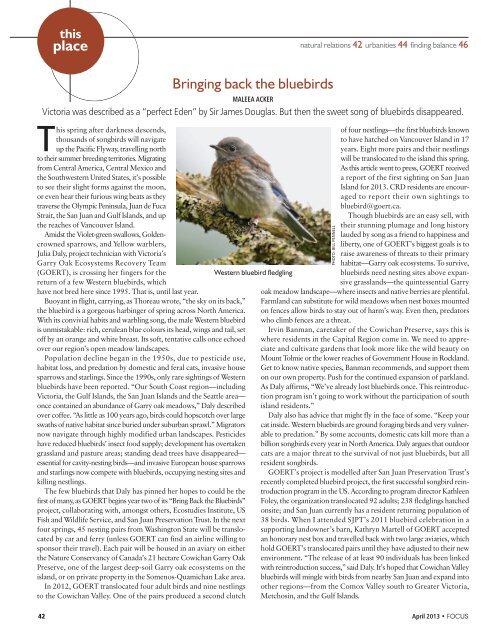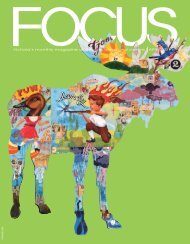You also want an ePaper? Increase the reach of your titles
YUMPU automatically turns print PDFs into web optimized ePapers that Google loves.
thisplacenatural relations 42 urbanities 44 finding balance 46This spring after darkness descends,thousands of songbirds will navigateup the Pacific Flyway, travelling northto their summer breeding territories. Migratingfrom Central America, Central Mexico andthe Southwestern United States, it’s possibleto see their slight forms against the moon,or even hear their furious wing beats as theytraverse the Olympic Peninsula, Juan de FucaStrait, the San Juan and Gulf Islands, and upthe reaches of Vancouver Island.Amidst the Violet-green swallows, Goldencrownedsparrows, and Yellow warblers,Julia Daly, project technician with Victoria’sGarry Oak Ecosystems Recovery Team(GOERT), is crossing her fingers for thereturn of a few Western bluebirds, whichhave not bred here since 1995. That is, until last year.Buoyant in flight, carrying, as Thoreau wrote, “the sky on its back,”the bluebird is a gorgeous harbinger of spring across North America.With its convivial habits and warbling song, the male Western bluebirdis unmistakable: rich, cerulean blue colours its head, wings and tail, setoff by an orange and white breast. Its soft, tentative calls once echoedover our region’s open meadow landscapes.Population decline began in the 1950s, due to pesticide use,habitat loss, and predation by domestic and feral cats, invasive housesparrows and starlings. Since the 1990s, only rare sightings of Westernbluebirds have been reported. “Our South Coast region—includingVictoria, the Gulf Islands, the San Juan Islands and the Seattle area—once contained an abundance of Garry oak meadows,” Daly describedover coffee. “As little as 100 years ago, birds could hopscotch over largeswaths of native habitat since buried under suburban sprawl.” Migratorsnow navigate through highly modified urban landscapes. Pesticideshave reduced bluebirds’ insect food supply; development has overtakengrassland and pasture areas; standing dead trees have disappeared—essential for cavity-nesting birds—and invasive European house sparrowsand starlings now compete with bluebirds, occupying nesting sites andkilling nestlings.The few bluebirds that Daly has pinned her hopes to could be thefirst of many, as GOERT begins year two of its “Bring Back the Bluebirds”project, collaborating with, amongst others, Ecostudies Institute, USFish and Wildlife Service, and San Juan Preservation Trust. In the nextfour springs, 45 nesting pairs from Washington State will be translocatedby car and ferry (unless GOERT can find an airline willing tosponsor their travel). Each pair will be housed in an aviary on eitherthe Nature Conservancy of Canada’s 21 hectare Cowichan Garry OakPreserve, one of the largest deep-soil Garry oak ecosystems on theisland, or on private property in the Somenos-Quamichan Lake area.In 2012, GOERT translocated four adult birds and nine nestlingsto the Cowichan Valley. One of the pairs produced a second clutchBringing back the bluebirdsMALEEA ACKERVictoria was described as a “perfect Eden” by Sir James Douglas. But then the sweet song of bluebirds disappeared.Western bluebird fledglingof four nestlings—the first bluebirds knownto have hatched on Vancouver Island in 17years. Eight more pairs and their nestlingswill be translocated to the island this spring.As this article went to press, GOERT receiveda report of the first sighting on San JuanIsland for 2013. CRD residents are encouragedto report their own sightings tobluebird@goert.ca.Though bluebirds are an easy sell, withtheir stunning plumage and long historylauded by song as a friend to happiness andliberty, one of GOERT’s biggest goals is toraise awareness of threats to their primaryhabitat—Garry oak ecosystems. To survive,bluebirds need nesting sites above expansivegrasslands—the quintessential Garryoak meadow landscape—where insects and native berries are plentiful.Farmland can substitute for wild meadows when nest boxes mountedon fences allow birds to stay out of harm’s way. Even then, predatorswho climb fences are a threat.Irvin Banman, caretaker of the Cowichan Preserve, says this iswhere residents in the Capital Region come in. We need to appreciateand cultivate gardens that look more like the wild beauty onMount Tolmie or the lower reaches of Government House in Rockland.Get to know native species, Banman recommends, and support themon our own property. Push for the continued expansion of parkland.As Daly affirms, “We’ve already lost bluebirds once. This reintroductionprogram isn’t going to work without the participation of southisland residents.”Daly also has advice that might fly in the face of some. “Keep yourcat inside. Western bluebirds are ground foraging birds and very vulnerableto predation.” By some accounts, domestic cats kill more than abillion songbirds every year in North America. Daly argues that outdoorcats are a major threat to the survival of not just bluebirds, but allresident songbirds.GOERT’s project is modelled after San Juan Preservation Trust’srecently completed bluebird project, the first successful songbird reintroductionprogram in the US. According to program director KathleenFoley, the organization translocated 92 adults; 238 fledglings hatchedonsite; and San Juan currently has a resident returning population of38 birds. When I attended SJPT’s 2011 bluebird celebration in asupporting landowner’s barn, Kathryn Martell of GOERT acceptedan honorary nest box and travelled back with two large aviaries, whichhold GOERT’s translocated pairs until they have adjusted to their newenvironment. “The release of at least 90 individuals has been linkedwith reintroduction success,” said Daly. It’s hoped that Cowichan Valleybluebirds will mingle with birds from nearby San Juan and expand intoother regions—from the Comox Valley south to Greater Victoria,Metchosin, and the Gulf Islands.PHOTO: BILL PENNELL42 April 2013 • FOCUS
















